(Editor’s note: This post was written by Tyler Dahl, a fountain pen restorer with extensive knowledge of these classic writing instruments. It was originally written as a 3 part series but has been edited into a single post for your convenience.)
Hello to all of you who are reading this article! My goal here today with The First Time Buyers Guide to Fountain pens is to help you in picking out your first fountain pen! It’s a difficult decision, and selecting the right one can be difficult. There are so many options, and with all the great articles and reviews out there, it can be mind-boggling to a beginner.
As with all my reviews and articles, I’m going to provide you with a little list of what we’ll be covering here. By breaking this down into categories, you should have an easier time not getting lost during reading, and scanning through if you bookmark it for reference.
Table of Contents
By the end of this series, you should be able to make a wise choice on selecting your first fountain pen. If you’re having a hard time, you can always send me an email, and get a personal response to your questions. Though I am a bit busy with business sometimes, I always make time to talk pens with people, especially beginners.
My personal writing style is very “conversational”. I hope you’ll enjoy it, cause I sure love writing it! The way I’m going to break up this into categories is by using questions, and answers. Here goes:
Why Would I Want a Fountain Pen
Now, with that list in mind, the best place to begin is at the beginning, with question No. 1.
I’ll begin with a shortlist of the benefits of using and owning a fountain pen.
- They’re downright fun. This may sound like a lame reason, but it’s not. Writing can sometimes become a chore and a burden. By using a writing instrument like a fountain pen, writing can become a joy!
- They’re better for your hands. Ever gotten cramps from writing? Chances are you were using an “ink-stick”. This is the term that fountain pen owners use to denote a ball-point pen, usually of the “100 for $5.00) variety. A fountain pen is much better for long periods of writing, allowing the hand to relax, and write without becoming fatigued.
- The personalization! Who doesn’t love a useful item, which is custom-tailored to your hand? This is what makes fountain pens so much fun! There is SO much to customize with a fountain pen. Here are some quick examples:
- There are thousands (hundreds of thousands) of pens to choose from. LOTS of variety. There is something there for everyone.
- Each pen can have a different type of nib, and a different filling system for drawing ink. For those of us mechanical geeks (like me), it’s really cool to pick out a pen with a complex ink drawing system.
- Ink colors! There are at least over 1000 different colors of inks available, from a variety of brands. You can’t even begin to approach that with a ballpoint! Best of all, a single pen can use as many different inks as you like, one at a time of course. This means that you can own only one pen, but you can have a stash of 20 inks (or more) to choose from, each time you re-fill.
- They can improve your handwriting and starting your children off early writing with a fountain pen so that they have neat handwriting can give them many benefits in life.
- Lastly (though there are many more reasons, I can’t give them all, for the sake of time), there is the nostalgia of using a fountain pen. Something sacred and wonderful about the “rituals” involved with caring for, and using it. Everything from filling it up, to cleaning it – it’s all special, and really keeps us close with our writing instrument. Sounds cheesy, but trust me, you’ll love it the first time you get to fill your fountain pen!
For me, a fountain pen is really just another tool. But it’s a special tool. One of the few tools that you can connect with, on a personal level. Though I consider myself a user, and not a collector, I still enjoy the intrinsic value of owning a fountain pen.
Indeed, in this modern-day of smartphones, and super-techy gadgets, it is downright refreshing to have a delightful tool that never runs low on batteries, never has software crashes, and never gets outdated!
If you still don’t want a fountain pen now, I don’t know what to tell you! After all, what could you not love about a fountain pen? Sure, they require some light maintenance, and a little upkeep/devotion, but with a fountain pen, it’s fun to perform these tasks, not annoying. If you’ve decided that you do indeed want a fountain pen, read on for more information.
Vintage or Modern?
So, you’ve finally made the decision to buy your first fountain pen, right? Well, now you’re probably looking at the dazzling array of different options available. There are hundreds of thousands of different pens on the market, and many of them have some extremely winning qualities. What you need to do is decide what you want for your fountain pen.
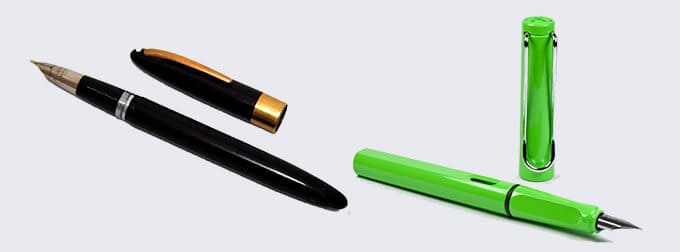
I group fountain pens into two main categories: vintage pens, and modern pens. There are ups and downs to both types of pens. I will explain here, the most important pros and cons of vintage and modern fountain pens:
Vintage Fountain Pens
Pros:
- You oftentimes get more pen for your $ than with a modern fountain pen.
- You get the added nostalgia of the pen being vintage.
- A vintage pen has a history behind it, each one has a unique story.
- You might just prefer the retro style!
Cons:
- Vintage pens tend to be more fragile (not all of them) than their modern counterparts.
- Vintage pens often need repair before they are functioning again. This is the same as restoring any antique when it has been out of use for a lengthy period of time. This is all dependent on where you buy your pen from. There are many reputable sellers of vintage pens who will guarantee them working for you. I will provide a list of places to purchase pens from at the end of this article.
- You might dislike the certain filling systems that vintage pens use. I personally love them! They are a lot more unique than most modern filling systems. I’ll talk more on filling systems in just a minute here.
Modern Fountain Pens
Pros:
- Modern pens are usually very sturdy, due to the new plastics we’ve invented recently. This is very important if you are a student, or work at a job where your pen will be subject to some light “abuse”.
- Many people, including me, prefer some of the modernly styled pens. Most particularly when you’re looking at a lower price range.
- Modern fountain pens are guaranteed to work when you get them unless of course, you have a strange occurrence of a manufactures defect. Luckily most companies and retailers will replace your pen if it’s not working properly.
- Most modern pens will last longer without the need to be refurbished. Vintage pens need their internal components replaced every 15-20 years, or more depending on the filling-system.
Cons:
- Modern pens can have a tendency to not write well out of the box. This is not uncommon, but it’s not extremely common either. It is something that you should be aware of. Luckily if your pens have been purchased from a good re-seller, they will make sure that the nib has either been tested beforehand or that they have a good return policy.
- You may dislike the filling systems available for modern pens. Most of them in the lower price range will feature filing systems that just aren’t as good as a vintage pen for the same price.
So now we’ve discussed the pros and cons of vintage and modern pens I am going to go into more detail on different aspects of them.
Fountain Pen Choices
Wow! There are so many choices! Can you explain them to me?
Design:
For me, a fountain pen must look aesthetically pleasing if it’s going to get anywhere near my “to-buy” list. I have a feeling that this is important to most of us. Form over function – yes, but I still want a pen that I enjoy looking at and handling. To best show you some different styles, I’ll go over the basics, and include lots of pictures!
Classic Pens
A classic pen, to me anyway, is a pen that shows a design that is not flashy, but not plain. It’s classy! Much like a fine suit, a classic pen is just the right thing for those who love formal, but not stiff.
Here is a personal favorite of mine. This pen is far beyond the price range we’re looking at in this article, but it’s the perfect example of a classically designed fountain pen. Shown below is a Pelikan M805 – Produced by a company founded in the early 1840s, known as the Pelikan Pen Company. This pen, however, is a modern pen, being produced in the last few years. Everything about this pen – the lovely pinstripes, the subtle trim, the beautiful nib – it’s a true perfectionist’s outcome of the word “classy.”

Check Price and Reviews on Amazon
Here is another classic-looking beauty. This one, however, is a vintage pen. This particular model is a Parker Vacumatic, in the “Major” size. The color is Azure blue. This pen has the same classic elegance the above pen, but you can tell it’s vintage, from certain features. There is simply a “thing” about vintage pens that set them apart.

Next up – “Cool” Pens:
For all you guys reading this article – here is your type of pen! “Cool” pens, as defined by me, are fountain pens that are just plain cool. The best example, of course, is a picture:
This here is a Pilot Vanishing Point, in the matte black color. This is a pen that I own myself and is one of my favorites. Though not cheap, this is certainly a viable option for a beginner’s pen, if you can afford it. If you really like this one, I’ve got a whole review of it here. This pen just screams “I’m cool”! And it’s the truth. Everything about the sleek lines, matte texture, and stylized clip – it all looks like something that Batman might use if he had a fountain pen (maybe he does…).

Check Price and Reviews on Amazon
Retro Pens!
This is one area where vintage pens are the winner every time. If you love that retro-awesome look, take a gander at this pen!
This pen here is an Esterbrook – an extremely popular brand of vintage fountain pens. This pen will be shown below, as it is one of my top recommendations for vintage pens! Coming in a variety of colors and sizes, the Esterbrook J series is one awesome looking pen. The pen below is a red Esterbrook, full-sized model. They come in green, blue, copper, grey, and black as well!
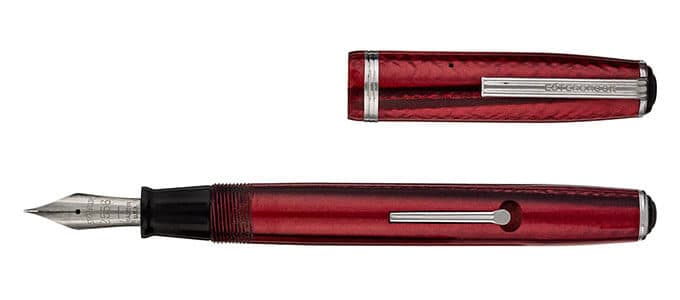
Elegant Pens:
These pens are usually very simple clean. They are very understated, but at the same time, they stand out in their own special way.
This here is a Pelikan M205 – all white, rhodium trim (silver-colored as opposed to gold colored). Many people tend to think of white pens as “ladies only” pens, but I disagree. I love white pens, though I will say that they are prone to staining, which is a disadvantage. The Pelikan M205 does come in a range of other colors.

Check Price and Reviews on Amazon
Modern Pens:
The pen below could also classify as cool, but it is such a perfect example of a modern pen, that I think it needs to be here.
This is the Lamy 2000 – a personal favorite of mine (reviewed here!). This pen is a beautiful clash of design and function. It’s a utility pen that looks like a piece of modern art. Very cool.

Check Price and Reviews on Amazon
Weird Pens:
A strange category, I know. :
I call any pen that is just abnormal, a “weird” pen. Here’s a prime example of one, being one of my favorite pens as well.
The TWSBI Diamond 540 (and 580). This pen is called a demonstrator. This means that it’s made of clear plastic, and is built in such a way that the internal components can be clearly seen. I really love demonstrator pens, but some people just don’t. I all comes down to a matter of personal preference.
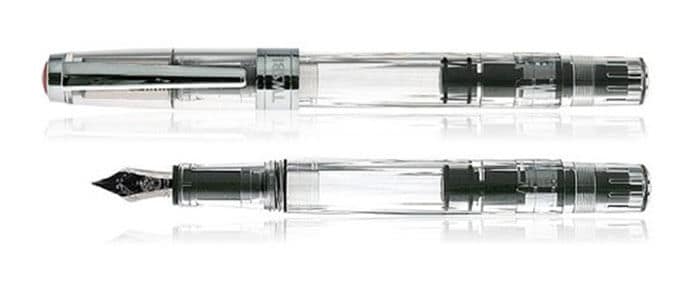
Check Price and Reviews on Amazon
Now that we’ve covered some of the different types of fountain pen designs out there, you will hopefully be able to better choose a pen that you like. It’s a tough choice, but just remember: feel free to experiment! Buy a pen, try it out, and sell or trade it later on. That’s why I highly recommend joining a community, like the Fountain Pen Network, where you can trade, and buy/sell with other FP enthusiasts.
Size:
This is very important to some people, so I thought I’d go over it real quick.
Some people find certain pens very uncomfortable due to their size. This is once again a matter of personal preference. I have always been the type who can use pretty much any sized pen, so long as it’s within the normal range (not XXXS or XXXL).
Here’s a quick comparison of some relatively common pens.
- Pelikan M800. I consider this a large pen, but not quite oversized. It’s very heavy though.
- TWSBI Diamond 540. This pen is almost the exact same size as the Pelikan M800, but it’s much lighter.
- Pilot Black Matte Vanishing Point is very long when the button is included, but since you wouldn’t want to rest your hand there, it drops down to the size of the next pen:
- Pelikan M200. This pen is a small pen. I think the size is very nice, but some people with large hands may find it to hard to use.
- Namiki Falcon. This is kind of a mid-range pen. Not big, not small. Pretty much right in the middle.
Another thing to consider for size is the thickness of the grip-section, simply referred to as the “section” by most of us. A Pelikan M800 has a very thick grip section, as does the Pilot Vanishing Point. The Pelikan M200 and Namiki Falcon both have much thinner sections.
I prefer a bigger section to grip on, as it’s more comfortable for me. Chances are though, if you’re not picky, you won’t have too many problems.
Nibs:
This is a very important consideration in choosing the right pen. The nib is the part of the pen that actually touches the paper, and makes the words (or lines if you like to draw). Without a good nib, any fountain pen (even the nicest one), is worthless, except for use as a decoration.
I’ll try to keep this is short but easy to understand. First I’ll cover nib sizes:

Nib Sizes:
It’s important to pick the right size of nib for yourself. You don’t want to end up writing with something so big that you can’t read your own cursive, and you don’t want a line so small that you can’t see it. This is purely personal preference again, so I will just show you the options and give you my personal suggestions.
All companies will offer you the choice of F, M, or B nib. That would be “fine”, “medium”, and “broad”. Some companies even offer XF, XXF, BB, and BBB options. We won’t get into those, because honestly, I think they’re a bad choice for a new FP user.
Sadly, there is no “standard” for sizing nibs. This means that one company F might be close to other companies’ medium. Generally speaking, Japanese made nibs tend to run a size smaller, and German nibs tend to run a size bigger.
Going off of what is approximately average, here’s what I recommend:
Fine nibs: If you like using 0.5mm lead in your mechanical pencil, and you love those nice ballpoints with the “ultra-fine” tips, I would recommend a fine nib for you.
Medium nibs: If you like using 0.7mm lead, and normal “BIC ink sticks”, you’ll probably love a medium nib.
Broad nibs: Do you like the soft line of those thicker HB pencils? Perhaps you like to write with a Sharpie “ultra-fine” marker? A B nib is very close to these, and will probably be very satisfactory to you.
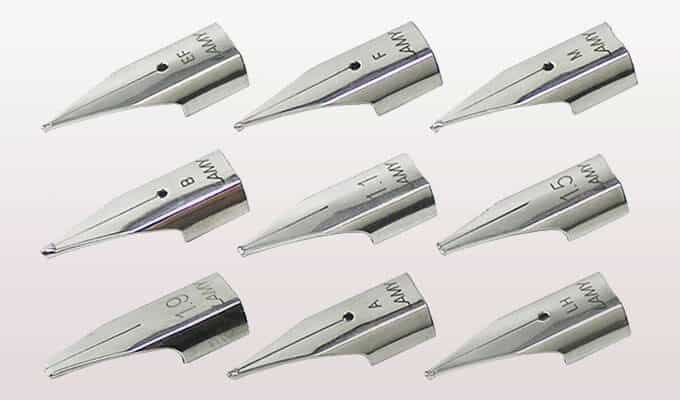
Once again, this boils down to a personal choice. I will say this – if you’re unsure, go with the smaller size. If you pick one to small, at least you can use it while you decide what to do. If you get a nib to big, you may not be able to even write with it.
Nib styles:
There are many different “types” of nibs that I simply won’t go into in this article. These are things to discover for yourself as you learn more about fountain pens. For a good starting point, read my extensive nib article here. This will jump-start you on all the basics of nibs, and a little beyond.
Editors Note nib article no longer available online
Nib materials:
Many pens offer luxurious 14k and 18k nibs. Most inexpensive pens offer steel nibs. There is much discussion on gold being better than steel, however, you can take my word for it – a steel nib, if properly tuned, can write just as good, if not better than any gold nib.
Filling Systems:
Yet another important aspect of selecting a new fountain pen: You need to select a filling system that you like. Loading up your pen with ink can become a chore if you have a filling system that requires re-filling often, is difficult to use, or is unreliable.
For the sake of time, I will cover the most common filling systems. These are the ones you will see first and will run into most often.

c/c filler:
A c/c filler is short for a cartridge/converter filling system. This is the most common filling system of all, especially with pens under $100.00. A c/c filler is a pen that is equipped to take a cartridge or a converter. A cartridge is a small plastic tube filled with ink. Once the ink is gone, you toss it. A converter, however, is for use with bottled ink and uses a small piston mechanism to draw ink into the pen. It is reusable until the mechanism wears out.

Pros:
- A c/c filler is convenient because you can keep a few spare cartridges in your bag or purse. Then if you run out of ink, you can refill on the go.
- Easy to replace if it ever becomes damaged, and new ones are only $5.00 or so.
Cons:
- Holds very little ink, in most cases.
- They’re just not very “fun” to use.
Piston filler:
A piston filler is like a giant version of a c/c filler. Instead of being a converting unit that is installed into the pen, a piston is built into the pen. Piston fillers are known for reliability and massive ink capacity. Pistons do need to be serviced every once in a while, but this is something that you can usually do yourself.

Pros:
- Holds lots of ink! This is very important to me.
- Very reliable.
- Piston fillers are very fun to operate and use.
- They don’t wear out under normal use.
Cons:
- They need to be serviced every once in a while.
- If you like to change ink-colors often, you may not like the huge capacity.
Lever filler:
Most commonly seen on vintage pens, lever fillers use an internal reservoir (made of latex, called a “sac”) to hold ink within the pen. Lever fillers are classic, iconic, and are very easy to use. They hold a moderate amount of ink and last for a very long time.

Pros:
- Fun and easy to operate.
- Last for a pretty long time before wearing out, and need no service along the way.
- It’s a classic!
Cons:
- They do eventually wear out, in about 30-50 years if properly taken care of. Replacement can be done at home if you’re adventurous and want to invest in some inexpensive tools. Otherwise, one can get them restored for around $25.00 – $30.00.
- Unlike modern plastics, they do not take abuse well. The internal latex sac can be destroyed if the ink is left to dry out in it for months without use.
Eyedropper:
An eyedropper pen is one that fills by using a syringe, or eyedropper to shoot ink straight into the pen barrel. These fillers hold the most ink of any kind, but they present some minor annoying problems.
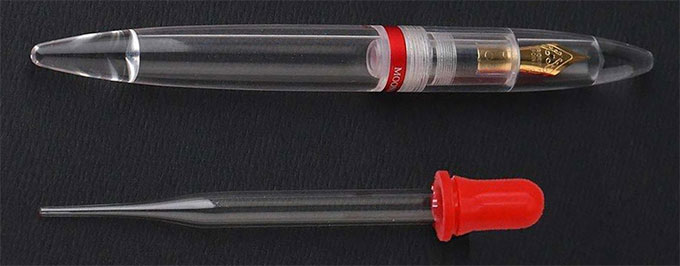
Pros:
- Holds TONS of ink!
- No maintenance, no mechanics, never wears out.
Cons:
- It can be inconsistent when it comes to ink flow.
- They can blob/drip ink onto the page during writing. High-end ones may have an air-valve to prevent this, but most of those are in the $300.00+ range. :
Okay, I think that has basic filling systems covered. Ready to move on? Good, so am I. There are dozens more filling systems out there, but I simply can’t cover them all.
Conclusion:
Ultimately, what you get is what you like. If you want an eyedropper-filler, and you don’t care if it has some minor problems, then go for it! I am just making suggestions and giving you the info you need to make a purchase that you’ll enjoy.
Be picky, be selective, have fun!
Recommended Fountain Pens for Beginners
What pens would you recommend for beginners?
There are thousands of different pens out there, and in such a dazzling array of styles and colors too. It’s mind-boggling to try to browse through them and find the right one. Lucky for you, I have some recommendations to help you find your first fountain pen! These are my top picks, but that doesn’t mean they’re the best, or everyone’s favorites. They are, however, all very popular, and they’re all great pens. Let’s jump right in!
For modern pens:
TWSBI Diamond 580
I love this pen. It’s my top pick for any new FP users – the first pen I always recommend. This pen has created a huge fan-base, due to the company’s excellent service, and how awesome the pen is.
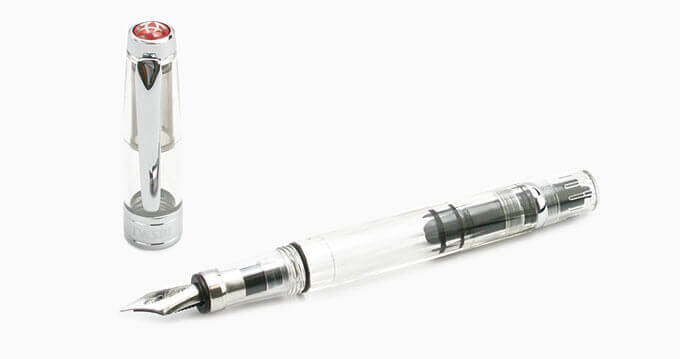
Details:
Price: $50.00
Filling system: Piston
Size: Medium/Large
Nib material: Steel
Let’s go over its pros and cons.
Pros:
- Very inexpensive for what you get. Lots of value for dollar here!
- Piston filler – holds lots of ink.
- Cool design! I love demonstrators.
- The company’s customer service is A++! They’re the nicest company I’ve ever dealt with. If something breaks on your pen, and it’s a manufacturing defect, they’ll send you a new pen or part for free, without a moment’s hesitation.
- Interchangeable nibs are a huge plus to me. Nib units screw in/out, with no mess, even when the pen is inked. The company gives you a case to hold the spare nib so you can swap nibs on the go!
Cons:
- You may hate the design. Some people do not like demonstrator pens…
- Steel nib – not really a con to me though. I love my TWSBI nibs.
- The nibs can be (rarely) hit or miss. I have heard mostly good reports, but just a few bad ones. Luckily, if it’s bad, you can get a free replacement, no questions asked!
Overall, I have yet to find a modern pen that even begins to compete with the 540’s value for $. There is nothing quite like it!
Check Price and Reviews on Amazon
Lamy Safari
German-made, and built like an absolute tank, the Lamy Safari is a superb pen that can really take a beating. It comes in some wild colors, and it does look a bit goofy. However, if you have a rough job, you’re at school, or you have small children who love messing with your stuff, this may be your pen. It’s practically indestructible.

Details:
Price: $28.00!
Filling system: c/c (cartridge converter – comes with converter)
Size: Large, but lightweight
Nib material: Steel
Some ups and downs:
Pros:
- Very inexpensive, period.
- Practically indestructible. This thing is not built like a tank, it is a tank!
- Has interchangeable nibs, though they’re not nearly as easy to swap as the TWSBI 580. The plus is that new nibs only cost about $11.00 – dirt cheap!
Cons:
- The design is not very nice, to me personally. The matte black version looks a bit better, but some of the brighter colors look very “pre-school” if you know what I mean.
- c/c filler. It does not hold a lot of ink.
Overall it’s a great pen, and it just doesn’t break. If you’re rough on your stuff, the Lamy Safari will not be failing you.
Check Price and Reviews on Amazon
Pilot Vanishing Point
One of my favorites in my collection. The Pilot Vanishing Point is a convenient pen, which is exactly what it’s designed for. It is one of the few pens that can be “operated” one-handed. There is no cap to this pen. Instead, it uses a clicking mechanism much like a ball-point, though it feels much smoother to operate.

Details:
Price: $130.00, give or take depending on the store.
Filling system: c/c (cartridge converter – comes with converter)
Size: Medium/Large
Nib material: 14k gold (with the exception of Limited Editions being 18k)
Pros:
- Really amazing, and convenient pen.
- Superfast for on the go writing.
- Very sturdy pen – great for travel.
Cons:
- You may hate the design. I love it. It’s usually one or the other – no in between.
- It does not hold a lot of ink. In fact, it holds a very tiny amount compared to other c/c fillers.
- Lacks the “elegance” of a traditional fountain pen.
- It’s expensive for what you get. It’s worth it, but it’s not quite as much value as the TWSBI 540.
I really love this pen, and I highly recommend it. To me, it’s worth the price if you’ve got the money to spend.
Check Price and Reviews on Amazon
For vintage pens:
Esterbrook J Series
One of my personal favorite vintage pens, Esterbrooks are what got me hooked on both vintage pens, and restoring them. Value for dollar, they’re amazing, and they come in such a variety, there’s one for everybody!

Details:
Price: $40.00 depending on where you buy it from. This is assuming it is restored to full working order.
Filling system: Lever filler.
Size: Small, medium, or large depending on which model you get.
Nib material: Steel.
Pros:
- It comes in a huge variety of sizes and colors. Three sizes, six colors. Lot’s to choose from!
- Lever fillers are classic and fun.
- Interchangeable nibs. The replacements are very cheap (approx. $10.00 for most, with the exception of rare ones), so you can have a huge variety of nibs to pick from.
- Lever fillers are very easy to flush clean. This makes routine maintenance a bit easier and faster.
Cons:
- It’s vintage, so naturally, it’s not “super” sturdy. It is strong enough to withstand perfectly normal use though.
- The nibs can be rather hit or miss. I recommend buying one from a restorer, who tests all the nibs before selling them. That’ll ensure you get a good one.
Overall, this is one of my top choices for anyone looking for a less-expensive vintage pen. They’re really fun! I more than highly recommend these.
Sheaffer Snorkel
A true classic. These pens are amazingly complex, and yet fun to use, and easy too. The filling system is pneumatic, utilizing air pressure via a plunger to compress an internal sac. The pen sucks ink through a tiny tube, called the “snorkel tube”. This makes it so that you never need to wipe your pen off after filling. Very nice!
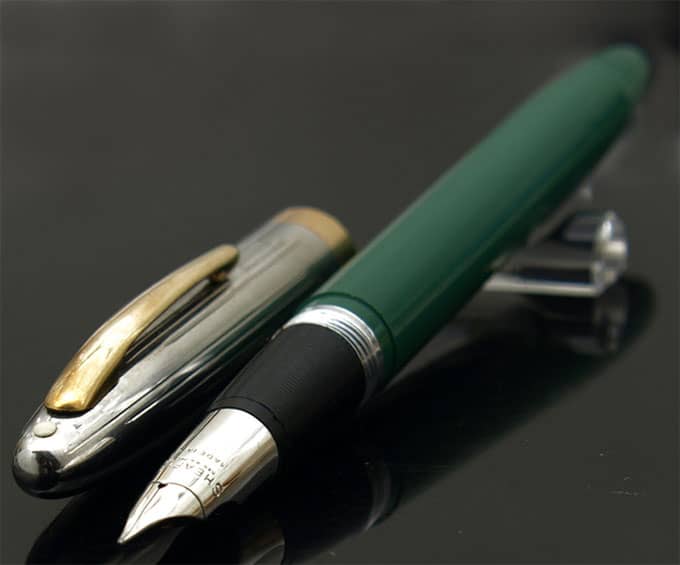

Details:
Price: $60.00 depending on where you buy it from. This is assuming it is restored to full working order.
Filling system: Snorkel/pneumatic.
Size: Medium.
Nib material: 14k gold, or steel, depending on the model.
Pros:
- Amazingly fun filling system.
- Mess free filling.
- Interesting/unique design.
- Comes in many colors and models
Cons:
- Though reliable when properly restored, it does require more maintenance than some pens to keep in good working condition.
- It’s not a “tank”. I’d call it sturdy, but not abuse-ready.
- The filling tube always looks so fragile to me! Luckily it’s retracted into the pen during use, so the chances of hurting are practically none.
Overall, I really love the entire Sheaffer snorkel “family” of pens. They’re fun, quirky, and really good writers (most of the time). Highly recommended if you’re willing to pay for one.
Parker 51
The face of reliable vintage pens – The Parker 51 is iconic, and is one of the best vintage pens ever made. I dare to say it is the best vintage pen ever made. I will keep to the Aerometric filling system for this article. The Vacumatic filling 51’s are great, but I much prefer the aeros, especially for beginners.

Details:
Price: $80.00 depending on where you buy it from. This is assuming it is restored to full working order.
Filling system: Aerometric
Size: Medium.
Nib material: 14k gold in most cases (there are some “octanium alloy” nibs out there).
Pros:
- It just never fails. Once properly restored, they’re as reliable as a fountain pen can be.
- They look cool!
- They can take a beating, and then some. For a vintage pen, it doesn’t get any more rock-solid than this.
Cons:
- It doesn’t exactly look like a fountain pen. I’ve had it mistaken for a ball-point on multiple occasions.
- Nibs can be really bad if you buy one un-restored. Stick to good/trusted re-sellers and restorers.
Overall, there is not a vintage pen I recommend more highly than the Parker 51. If I had to bet money on a pen being reliable and good, my thoughts will always go to this one. If you can afford the cash, I urge you to buy one.
Where Can I Get One?
The last and final section of this series. Now that you’ve (hopefully) picked out a pen you like, you’re probably ready to buy your first fountain pen! The question is: where on earth do you get one? Well, there are lots of places to shop. some are good, some great, and others are not worth looking at. I’ll go over my favorites here, as well as the ones to avoid. Once you have your fountain pen you will need to buy a good case to store it in there are nearly as many pen cases as fountain pens so take a look at the 10 best fountain pen cases which also has a comprehensive buyers guide.
Recommended:
Goulet Pen Company
Goulet Pen Company – Probably my favorite online retailer of pen and ink stuff. They’ve got a huge selection, good prices, and amazing customer service. The owners of the business (Brian and Rachel + “the team”) are young, energetic, and fun people to deal with. Highly recommended.
Fountain Pen Network
Fountain Pen Network – There is a marketplace section, where great deals can be had on new and old pens, vintage and modern – there’s a little bit (well, a lot actually) of everything! I have gotten the best deals on the FPN marketplace, and the forums are a great place to be too if you like to chat pens.
NOTE: You must have an account to sell on FPN. There a few other minor requirements. You can read the rules here.
There are quite a few folks who re-sell restored vintage pens, including myself. Here is a list of the ones I trust the most:
Tyler Dahl – Fountain Pens
Editors Note: Tyler is not currently restoring fountain pens for sale and he has now taken down his website
Tyler Dahl – Fountain Pens – Well, of course, I trust myself! Each month I put up around 12 restored vintage (and some modern) pens for sale. All are in fully functional order and are guaranteed for a year. I occasionally do sales too, (New Year’s day coming soon!).
Richards Pens
Richard’s Pens – As a fountain pen repairman myself, I greatly look up to Richard Binder. He is an icon of the FP world. He also lists a monthly tray of vintage restored pens. His prices are more on the premium side, but the pens he sells are certainly well worth it, coming from such a master restorer.
Main Street Pens
Main Street Pens – Ron Zorn – Ron Zorn is another restorer who I really look up to. He’s been in the business for many years and is nothing short of amazing. He has a sales page that is updated every so often with newly restored pens. Again, prices are on the premium side, but his work is worth it.
Stores to avoid!
I don’t want to name individual stores to avoid, so I’ll just give you some rules/guidelines to go by:
- If you’re buying a vintage pen, make sure the restorer is trustworthy and offers a good warranty. The three restorers shown above all offer 1-year warranties. I’d personally recommend nothing less, but if you’re comfortable with a 3, or 6-month warranty, that might be an option. Just make sure it has one.
- Make sure you’re not paying for a “name”. Buying directly from the manufacturer, or from a high-end retail store will just cost more for the name on the package. I like to buy used, but if you want new, seek out the lowest price, without compromising quality and customer service of course.
There is just one “store” I will specifically point out to avoid, for beginners. This doesn’t apply to “seasoned” FP buyers.
Do not buy from eBay!
Let me say that one more time: Do NOT buy a pen (especially a vintage one) from eBay. You just don’t know what you’re getting. I’ve purchased dozens of pens that were “restored,” only to find them in need of a complete (real) restore upon arrival.
Well, I think that’s just about it! I’ve hopefully given you all the info you need to make a good, solid, wise, and enjoyable first-pen purchase.
About the Author:
Editors Note: Unfortunately it looks like Tyler is no longer restoring and selling pens as he has taken down his website, however, the excellent advice that he has given in The First Time Buyers Guide to Fountain Pens is still as relevant today as when he first wrote this post.
Tyler Dahl is a young and enthusiastic fountain pen fanatic. The youngest professional pen-repairer currently out there, Tyler spends much of his time with inky hands and broken pens.
He keeps plenty busy running his part-time restoration business, and two different blogs: Tyler Dahl Fountain Pens, and The Repairer’s Bench.
When he’s not blogging or repairing pens, he’s currently working on building a small house with his family in Tennessee and helping run the family farm.
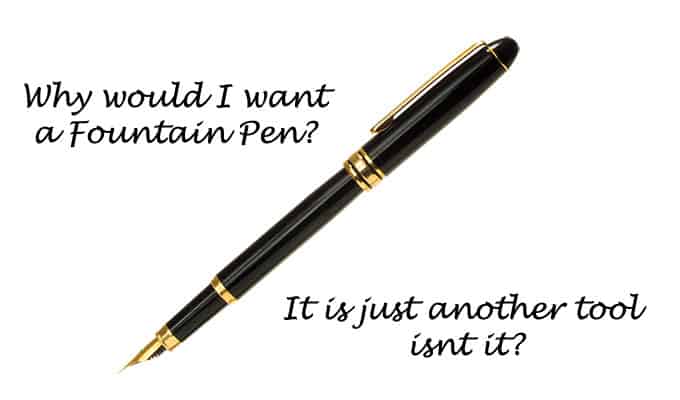
My sister’s birthday is fast approaching, and I would like to give her something that she’s fond of collecting, and that is a pen. Maybe a fountain pen could be a great gift because I agree with you that it is a kind of pen wherein a person can connect with on a personal level. Aside from vintage pens, I feel like buying her a more modern pen as well, which is the handcrafted rollerball business pen.
I would definitely get her a fountain pen as I am sure with a little practice she will enjoy writing with it. I had a quick look at your handcrafted rollerball pens that you have linked to which is why I assume you left the comment. I am sorry two words instantly spring to mind “ugly” & “expensive”
Great, great article, truly. Like the look of the fountain pen and would like to buy some vintage pens, but when I looked them up, the cheapest was 75 dollars. And with that they say the barrel is a little out of round and this one was cracked and this one doesn’t have a clip and this one “looks like they used it a lot”, meaning there is significant wear. YET, these pens are going for 100, 200, 275 up to 600, 800 even 1500 dollars.
So, how can I find a vintage pen, pre 1970, without paying, for the guy selling it, for his house and fancy car and suits and big trips??? I did go to your recommended sites and the same. Really need help with this.
I hear people say they just love pens and this is there second job or side business, but then why charge so much for a pen???
Lastly, I was at the pen show in D.C. and I didn’t see (doesn’t mean there wasn’t sales done) but I did not see many transactions. Some of these guys are charging ridiculous prices, especially from the “asian market” and I saw one guy selling his pens for $36.00. He used acrylics as other companies do, yet they charge 5 to 10 times what he does and I don’t mean the nibs with gold either.
It’s just another frustrating “hobby” and not conducive to get your kids involved because all these people think they are “rock stars” and they fall way short. Also, the pen, let’s face it, well, trying to be nice here, are a very simple tool and most who restore these nibs dont actually make the nib from scratch.
I just wish the pen people would stop charging hundreds for pens that are not worth that, not counting gold or jewels put into the pen.
Thanks for reading.
P.S. sorry it was a long read.
James.
P.S. I really like the heavy pens and wish the price would come down because I can’t bring myself to pay 4 or 500 dollars or more for a pen, even if I can afford it (I can afford it), but as a business decision it is ALL WRONG and as luxury decision it is morally wrong when that money could help many, many people instead of putting ink to paper, which will never come back like in the “old days.”
Hi James
Thanks for some great comments really enjoyed reading them, as you rightly say the 2nd hand pen market is a minefield with some outrageous prices being quoted. I would look for recommendations for where to buy from somewhere like the Fountain Pen Network forum, https://www.fountainpennetwork.com/forum/.
If you have not visited it before it is a great source of information, a lot of people on there are true pen enthusiasts who are really knowledgeable and helpful.
It is new to my knowledge that getting cramps while writing is due to ink-stick found in the usual pens. As a traditional writer, I prefer writing my manuscript by hand, and finding a good pen that suits this practice will be a great help. I am planning to buy a fountain pen since you mentioned that they are so much better for the hands. I’ll probably look for a good pen store that offers the best type of fountain pens.
this post was very helpful.